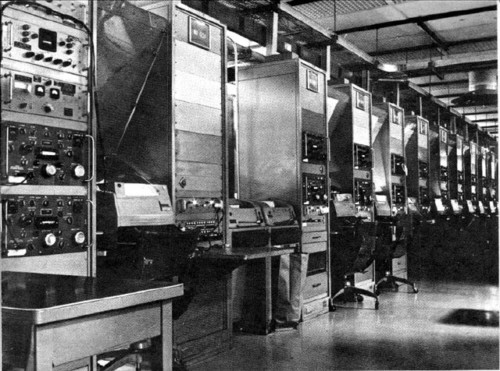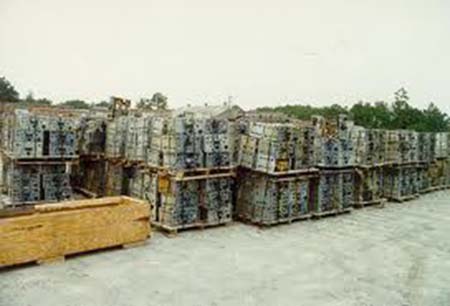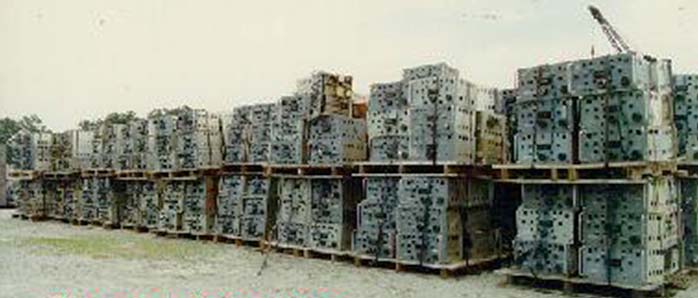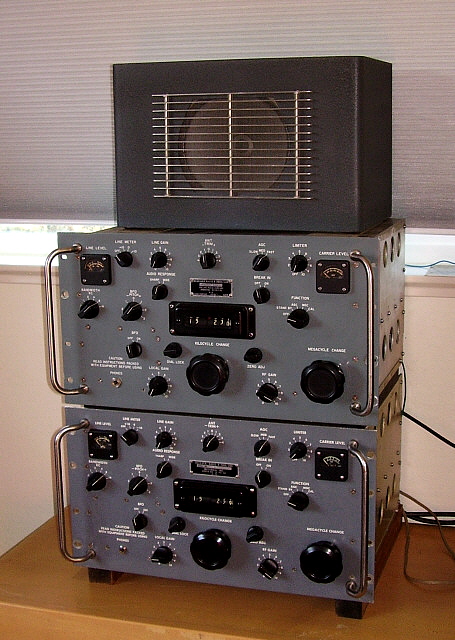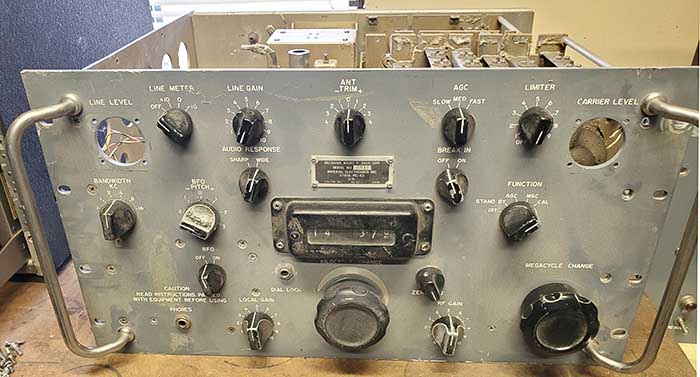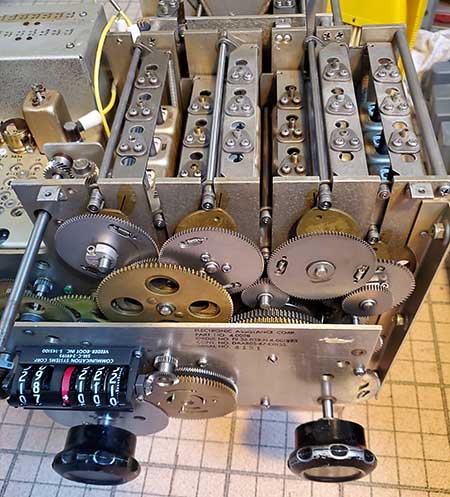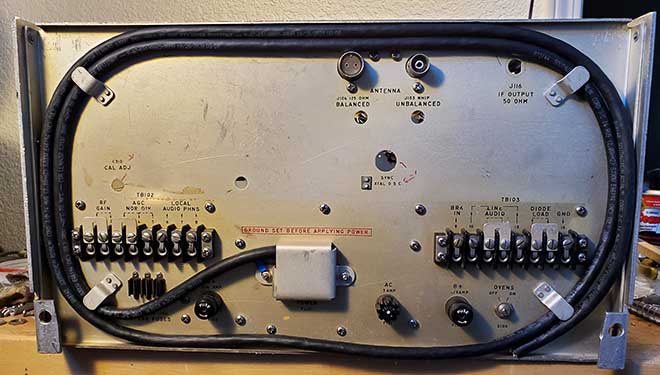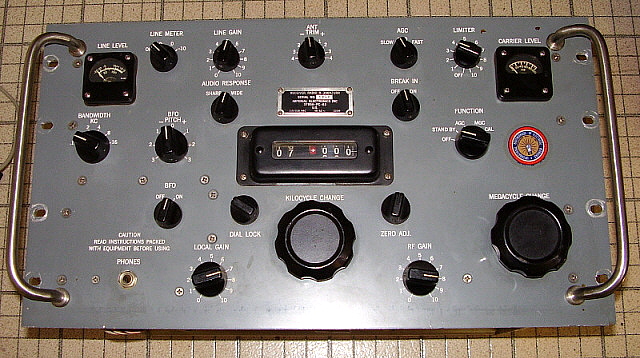| I've used many R-390A receivers in my various ham radio
and vintage military radio station set-ups over a period of many years. My first R-390A was a 1959
Stewart-Warner version that worked pretty well "as-is" when I got it
from a ham swap meet in 1991. I used it with an Eldico SSB-100F
transmitter I had and performance was great. A few years later I
obtained an excellent EAC version from 1967 but I sold it to buy a 1951
contract Collins R-390 installed in a CY-979 cabinet. I still own and
use the R-390 on a regular basis. I sold the 1959 Stewart-Warner after
obtaining a 1955 Collins R-390A. This Collins R-390A was given to me as
payment for repairing and rebuilding a Motorola R-390 for a fellow ham.
Eventually, I "wheeled and dealed" my way into a 1956 Motorola R-390A, a
1961 Capehart R-390A and a "Blue Striper" survivor from St. Julian's
Creek Annex. In 2016, a bargain-priced 1967 EAC was purchased. It needed
a little TLC and turned into a great receiver. Another '67 EAC showed up
at a bargain price in 2017. In 2019, I traded some BC gear to a fellow
collector for his entire stock of R-390A parts sets and modules. From that
collection I was able to recreate an original Arvin Industries R-725
(R-390A with R-390 IF deck.) I've used all of these receivers except the
"Blue Striper" at one time or another, both as an SWL receiver or as a
Station receiver.
Here's what I like about the
R-390A,...
1. If you absolutely must know exactly where in the electromagnetic
spectrum you are listening, the R-390A and its family are the most
frequency-accurate readout available in vacuum tube receivers. It's easy
to achieve 1/2 kc accuracy or better. The mechanical-digital readout
eliminates the vague interpretations of reading analog dials.
2. If you think you're going to be bothered by QRM, remember the R-390A was designed to
intercept radio signals from the USSR, China, Cuba, East Germany and other
Communist countries and to be able to successfully copy those signals
through any kind of interference whether natural or man-made. The R-390A
also provided reliable communications, including mobile RTTY, despite
jamming efforts from some of our Cold War adversaries. The receiver can
cope with just about any type of amateur interference since it was
designed to work through "professional-level" QRM.
3. When the R-390A is rebuilt and correctly aligned it is very
competitive as far as sensitivity is concerned. Are there more sensitive
receivers? Of course. But sensitivity isn't all that's required to
successfully copy weak signals. Nowadays, the ability of a receiver to
function well in a noisy EMI environment is far more important than an
"under a microvolt sensitivity" spec. After all, when your
local EMI noise floor is a constant S9, what good is .25uv sensitivity? When all the available controls are
taken into account along with the mechanical filter selectivity (and the user is very familiar with the operation and
capabilities of the receiver) the R-390A is almost unbeatable as a
station receiver.
4. Stability is the best in vacuum tube designs. Drift is
non-existent.
5. You have two individual audio outputs on an R-390A. The LOCAL
AUDIO is normally used to drive a 600Z ohm speaker set-up but you can
also use the LINE AUDIO for the same thing - simultaneously! The LINE
AUDIO was normally used to drive data devices like RTTY TUs, etc., but
there's no reason it can't drive any 600Z load - like another speaker.
I've set up a speaker in one room run by the LINE AUDIO and a second
speaker in another room run by the LOCAL AUDIO. Independent audio levels
in separate rooms. Really neat. OR,...if you just want to
utilize the LINE LEVEL meter to show a response to the audio component
of the signal then install a 680 ohm 1/2W resistor across the LINE AUDIO
terminals. You can now turn on the LINE GAIN and select the LINE METER
scaling and the LINE METER will respond to the audio component of the
received signal.
6. Everything about the R-390A's construction is "heavy-duty" and its
use metal knobs imparts a massive "feel" to the receiver's operation.
The R-390A has a certain impressive presence that attracts the attention
of ham shack visitors. This seems to be true whether the visitor is
familiar with the R-390A receivers or not. |
The following might be concerns
for some users,...
1. On SSB and the Meters
- Although there were a couple of military SSB adaptors , the CV-591A
(aka MSR-1 or MSR-4) and the CV-157, available and several modifications
have been published and other add-on devices available for demodulating SSB
produced, none of these are necessary for receiving
undistorted SSB
signals. Unfortunately, many new R-390A owners have only used modern
equipment (with SSB Product Detectors) before going to the R-390A which
only has a simple Envelope Detector. They expect the R-390A to be
adjusted for SSB reception just like their modern receiver - RF GAIN at
maximum with the AVC (AGC on the R-390A) on and volume level set by the
AF GAIN (LOCAL GAIN on the R-390A.) The R-390A can't be operated like
that when receiving CW or SSB. Before product detectors came along it
was standard procedure when receiving CW or SSB to reduce the RF GAIN
and advance the LOCAL GAIN (AF GAIN) so that the proper ratio of
incoming signal to BFO injection could properly demodulate either CW or
SSB. AGC was usually turned off but it depended on the receiver design. With
the R-390A, AGC can be left ON to limit the maximum response, if
desired. If the R-390A's BFO is properly set-up, its position allows
selecting either upper or lower sideband. Now, you do lose the function
of the CARRIER LEVEL meter (and most AGC action) in this method of reception but who cares?
The CARRIER LEVEL meter measures DB over 1uV and its accuracy depends on
the RF GAIN setting. If you were planning to use the CARRIER LEVEL meter
for CW or SSB signal reports, most stations wouldn't even know what
you're talking about when your report was so many "db over 1uV." It's
all a relative measurement anyway, dependent on the frequency and
conditions. It's better to operate the R-390A as a standard pre-product
detector receiver for CW and SSB and just give your contacts an
estimated R-S-T report.
2. More on the subject of SSB
reception and Modifications - The CV-591A family of SSB
adapters were built by The Technical Materiel Corporation. These
adapters work from the IF output, therefore you lose the Noise Limiter
function, the 800 cycle filter function and the dual audio section of
the R-390A receiver if you utilize only the audio output section
of the CV-591A. Now, if you happen to have an extra speaker, you can
connect one to the CV-591A output (8.0Z or 600Z) and the other one to
the R-390A's LOCAL AUDIO (600Z only.) If you want to do SSB or CW you
can use the CV-591A and its speaker. If you want to do AM, then use the
R-390A's LOCAL AUDIO and speaker. The CV-591 will provide excellent,
distortion-free SSB reproduction and they are well-worth using.
The only disadvantage is the price that the CV-591A is fetching today,
sometimes selling for more than the R-390A receiver.
On modifications to enhance SSB reception,...most of the mods that
have been published do not improve the receiver's overall
performance. Most modifications on any piece of vintage radio equipment
will enhance performance for one area at the expense of overall
performance. Besides, modifying a vintage receiver to make it operate
like a "modern" piece of equipment seems to go against the whole idea of
collecting, restoring, operating and preserving these classics in the
first place. You're better off to learn how to use the R-390A properly
and when you do, you'll find that modifications are not necessary for
great performance in all conditions and in all modes.
3. On Audio Quality
- Audio reproduction is not as bad as a lot of "BC-Quality AMers" complain it is.
The mechanical filters provide a specific, very steep-sided bandwidth
but some AM op-listeners are used to the "bell curve" that many early
vacuum tube receivers had with only two fairly broad-tuned IF
amplifiers. "Ringing" or a "hollow sound" were the usual complaints
about the mechanical filter bandwidth. If you change the LOCAL AUDIO
coupling capacitors to .022uf and then use a high quality 600Z
transformer with a large speaker in a good enclosure, the audio sounds
very nice, especially in the 8KC bandwidth (which is really close to
11KC) on AM with marginal signals or 16KC with a really great signal
level (AM or SW Broadcast but it's hard to find quality program material being
broadcast.) You'll have to do the
same thing to the LINE AUDIO if you want to run dual audio lines to two
separate speakers. However, if you're really into high-fidelity, then you can
take the signal from the DIODE LOAD and run it through a shielded cable
to a high-fidelity audio amplifier that's connected to a large hi-fi
type speaker system. At 16kc bandwidth, AM signals will sound
incredible. As with the SSB adapters though, you'll lose the NOISE
LIMITER and 800 cycle audio filter functions with this "hook-up" unless
you provide a separate speaker on the LOCAL AUDIO line (just in case you
want to do CW.) For most users though, especially if you're using
typical communications loudspeakers, the stock audio sounds pretty
good and the original .01uf coupling caps are fine. I've only
substituted the .022uf on a couple of R-390A receivers (and that was
done years ago) and it's
difficult to tell the difference between those receivers and the ones
with stock coupling caps. |



